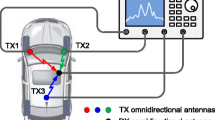Abstract
Ultra wide band (UWB) may offer very efficient solutions for various communication and sensing applications. Two approaches have emerged, which meet all the communication requirements: impulse and multi-band systems. The present work is concerned in the second approach. So, we propose to use orthogonal functions called Modified Gegenbauer Functions (MGF) in a multi-band UWB system occupying the 3–6 GHz frequency band. Different scenarios are studied and compared in the scope of a system offering communication and location capabilities for subway trains. In order to evaluate the performance of the proposed system, the bit error rate (BER) values for communication are calculated and analyzed in the presence of multi-user interference, assuming asynchonous users. It is shown that Gegenbauer functions offer the performance required for our multi-band UWB communication and location system.
Similar content being viewed by others
Abbreviations
- UWB:
-
Ultra wide band
- FCC:
-
Federal Communication Commission
- GPS:
-
Global positioning system
- BER:
-
Bit error rate
- DS-CDMA:
-
Direct sequence code division multiple access
- AWGN:
-
Additive white Gaussian noise
- MGF:
-
Modified Gegenbauer function
- FH:
-
Frequency hopping
- ETSI:
-
European Telecommunication Standards Institute
- PHY:
-
Physical layer
- MAC:
-
Medium access control layer
- USB:
-
Universal serial bus
- WiMAX:
-
Worldwide interoperability for microwave access
References
Benedetto M.-G., Vojcic B.R. (2003) Ultra wide band (UWB) wireless communications: A tutorial. Journal of Communication and Networks, Special Issue on Ultra-Wideband Communications 5: 290–302
Scholtz R.A. (1993) Mutiple access with time hopping impulse modulation (pp. 447–450). MILCOM., Boston
Batra, A., et al. (2004). Multi-band OFDM physical layer proposal for IEEE 802.15 task group 3a. IEEE P802.15-03/142r2-TG3a, Sep. 2004.
Available: http://ieee802.org/15/pub/TG3.html.
Saberinia, E., & Tewfik, A.H. (2003). Multi-user UWB-OFDM communications. In Proceedings 2003 IEEE Pacific Rim Conf. on Communications, Computersand Signal Processing (Vol. 1, pp. 127–130).
Batra, A., Balakrishnan, J., Dabak, A., et al. (2003). TI physical layer proposal for IEEE 802.15 task group 3a. IEEE P802.15-03/142r2-TG30, March 2003.
Abramovitz M., Stegun, I.A. (Eds.). (1972). Orthogonal polynomials. In Handbook of mathematical functions with formulas graphs and mathematical tables. Dover, New York
Elbahhar F., Rivenq-Menhaj A., Rouvaen J.M., Heddebau M., Boukour T. (2005) Comparison between DS-CDMA and modified Gegenbauer functions for a multi-user communication ultra wide band system. I.E.E. Proceedings Communications 152: 1021–1028
Elbahhar, F. (2004). Multi-user ultra wide band communication system based on modified Gegenbauer and Hermite functions. Ph.D., University of Valenciennes (France).
Elbahhar F., Rivenq-Menhaj A., Rouvaen J.M. (2005) Multi-user ultra wide band communication system based on modified Gegenbauer and Hermite functions. Wireless Personal Communications (Kluwer) 34: 255–277
Proakis J.G. (2001) Digital communications. Mc-Graw Hill, New York
Rappaport, T.S. (2002). Wireless communications principles and practice (2nd Ed.). Prentice Hall Inc.
Lindsey W.C., Simon M.K. (1973) Telecommunication systems engineering. Prentice-Hall, Englewood Cliffs, NJ
Prabhu V.K. (1976) PSK performance with imperfect carrier recovery. IEEE Transactions Aerospace Electronic System 12: 275–285
Viterbi A.J. (1966) Principles of coherent communication. McGraw-Hill, New York
ETSI, “Electromagnetic compatibility and radio spectrum matters (ERM); short range devices (SRD) using ultra wide band (UWB) technology for communication purposes in the frequency range 3.1 GHz to 10.6 GHz; Harmonized EN covering essential requirements under article 3.2 of the R&TTE Directive. December 2005 European Standard, ETSI EN 302 065 Draft v0.0.1.
Young, D.P., Keller, C.M., Bliss, D.W., & Forsythe, K.W. (2003). Ultra wideband (UWB) transmitter location using time difference of arrival (TDOA) techniques. In Thirty-Seventh Asilomar Conference on Signals, Systems & Computers (Vol. 2, pp. 1225–1229).
WiMAX Forum, September 2005. WiMAX Homepage, http://www.wimaxforum.org/home.
Tugnait J.K., Tong L., Ding Z. (2000) Single-user channel estimation and equalization. IEEE Signal Processing Magazine 17: 16–28
Proakis J.G., Nikias C.L. (1991) Blind equalization (overview paper). Proceedings of SPIE 28: 76–87
Verdu S. (1986) Minimum probability of error for asynchronous gaussian multiple-access channels. IEEE Transactions of Information Theory IT–32: 85–96
Varanasi M.K., Aazhang B. (1990) Multistage detection in asynchronous code-division multiple-access communications. IEEE Transactions of Communication COM–38: 509–519
Divsalar D., Simon M., Raphaeli D. (1998) Improved parallel interference cancellation for CDMA. IEEE Transactions of Communication 46: 258–268
Holtzman, J.M. (1992). CDMA power control for wireless networks third generation. In Wireless Information Networks. Kluwer.
Ziemer R.E., Peterson R.L. (1992) Introduction to digital communication. Macmillan, New York
Cameron R.A., Woerner B.D. (1996) Performance analysis of CDMA with imperfect power control. IEEE Transactions of Communication 44: 777–781
Author information
Authors and Affiliations
Corresponding author
Rights and permissions
About this article
Cite this article
Lamari, A., Elbahhar, F., Rivenq, A. et al. Performance Evaluation of a Multi-band UWB Location and Communication System Based on Modified Gegenbauer Functions. Wireless Pers Commun 48, 361–384 (2009). https://doi.org/10.1007/s11277-008-9527-9
Received:
Accepted:
Published:
Issue Date:
DOI: https://doi.org/10.1007/s11277-008-9527-9




